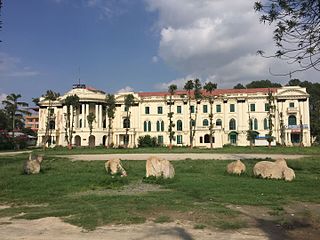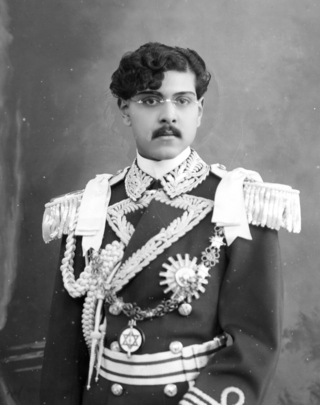
Tribhuvan Bir Bikram Shah was King of Nepal from 11 December 1911 until his death in 1955. Born in Kathmandu, the capital city of Nepal, he ascended to the throne at the age of five, upon the death of his father, Prithvi Bir Bikram Shah, and was crowned on 20 February 1913 at the Nasal Chowk, Hanuman Dhoka Palace in Kathmandu, with his mother acting as regent. At the time of his crowning, the position of monarch was largely ceremonial, with the real governing power residing with the Rana family.

Mechi was one of the fourteen zones of Nepal until the restructuring of zones to provinces, comprising four districts; namely Ilam, Jhapa, Panchthar and Taplejung. Its headquarters are at Ilam. It comes under the Eastern Development Region of Nepal. The Indian state of Bihar is to the south, West Bengal and Sikkim in the east and Tibet to the north. The largest town is Damak in the Terai. The majority of the population in Mechi are Limbu, Chettri, Bharmin, Maithil and Meche.

Kurseong is a town and a municipality in Darjeeling district in the Indian state of West Bengal. It is the headquarters of the Kurseong subdivision.

Birganj is a metropolitan city in Parsa District in Madhes Pradesh in southern Nepal. It lies 135 km (84 mi) south of the capital Kathmandu, attached in the north to Raxaul on the border of the Indian state of Bihar. As an entry point to Nepal from Patna, Birganj is known as the "Gateway of Nepal". It is also called the "Commercial Capital of Nepal". The town has significant economic importance for Nepal as most of the trade with India is via Birganj and the Indian town of Raxaul. The Tribhuvan Highway links Birgunj to Nepal's capital, Kathmandu.

There are two base camps on Mount Everest, on opposite sides of the mountains: South Base Camp is in Nepal at an altitude of 5,364 metres (17,598 ft), while North Base Camp is in China at 5,150 metres (16,900 ft).
Giri is an Indian surname, which literally means hill. It is subcaste of Goswami Brahmin or Gosains Caste. Giri is among the 10 surname of goswami community Bharti, Giri, Puri, Saraswati, Aashram, Parvat, Sagar, Van, Aranya, tirth. The surname is also found among Mahishya and some other communities of Bengal.

Subarna Shamsher Rana was a leading figure in the movement to overthrow the ruling Rana oligarchy and to establish democracy in Nepal. He was one of the three leaders of the Nepali Congress in the late 1940s, opposing his relatives, the Rana family, who held power in Nepal at the time.
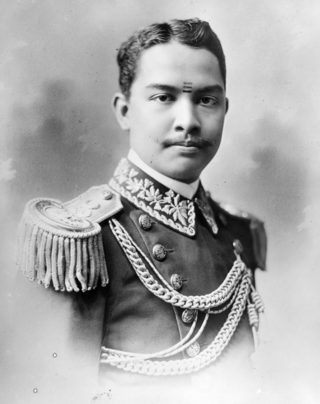
Field Marshal Sir Kaiser Shumsher Jang Bahadur Rana, GBE was a field marshal in the Royal Nepalese Army. He was the third son of Maharaja Sir Chandra Shamsher Jang Bahadur Rana, GCB, GCSI, GCMG, GCVO the fifth Prime Minister of Nepal of the Rana dynasty and Bada Maharani Chandra Loka Bhaktha Rajya Lakshmi.
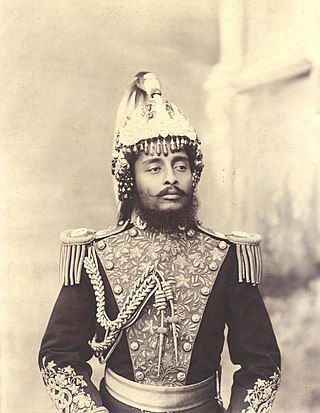
Field-Marshal His Highness Maharaja Sri Teen Chandra Shumsher Jung Bahadur Rana was the Prime Minister of Nepal from the Rana dynasty. He served in this capacity from 27 June 1901 to his death in 1929 after he successfully deposed his liberal and reformist brother Dev Shamsher. Although generally perceived as despotic and conservative, he is credited with several reforms including the abolition of slavery and establishing the Nepal-Britain Treaty of 1923, which recognised Nepal as an independent nation and an ally of Britain.

Birtamod is a municipality in Jhapa District of Nepal. It is the commercial, educational and transport hub of Jhapa District. Sarnamati Bazar, Dhulabari Bazar, Dhaijan Bazar, Charali Bazar, Shivasatakshi Bazar, Kamatoli Bazar, Chakchaki Bazar and Surunga Bazar are some of the nearest local towns/settlements connected to Birtamod. It is one of the fastest growing cities in Nepal. Birtamod is one of the largest city of Jhapa.

Shrimant Maharaja Sir Pratap Singh Rao Gaekwad, who belonged to the Gaekwad dynasty of the Marathas, was the ruling Maharaja of Baroda. He succeeded to the throne upon the death of his grandfather Sayajirao Gaekwad III in 1939. In 1947, British India was partitioned into two independent dominions, and Pratap Singh acceded his state to the Dominion of India. By 1949, Baroda had been merged into India.
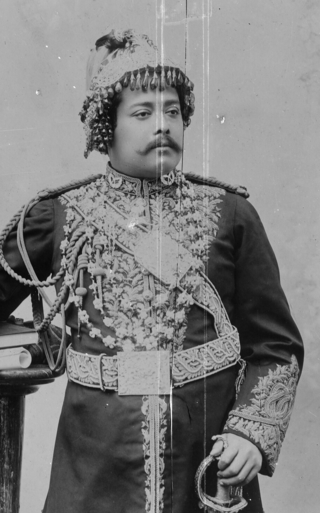
Sri Maharaja, Dev Shumsher Jung Bahadur Rana was the Prime Minister of Nepal for 114 days in 1901. He was also the King of Lamjung and Kaski.
Kimathanka is a Village in Bhotkhola rural municipality of Sankhuwasabha District of Province No. 1, Nepal and serves as the Nepalese counterpart of the Nepal-China border at Zhentang (Chentang). At the time of the 1991 census, it had a population of 303 people living in 50 individual households.
Phulbari also known as Fulbari is a road border crossing for vehicles and people on the India-Bangladesh border and a proposed municipality in Rajganj community development block in Jalpaiguri district in the Indian state of West Bengal. The Bangladesh side of the border crossing is Banglabandha.

Ranighat Palace or Rani Mahal is a historic Rana palace located on the banks of Kali Gandaki River in Palpa district of Nepal. This palace was constructed by General Khadga Shamsher Jang Bahadur Rana in 1893.

Kaiser Mahal is a Rana palace in Kathmandu, the capital of Nepal. The palace complex, located west of the Narayanhity Palace, was incorporated in an impressive and vast array of courtyards, gardens and buildings.

Pharping is a small Newar town lying above the Bagmati river on the southern edge of the Kathmandu valley, about 23 km from the capital. It is now part of the Dakshinkali Municipality.

Dhir Shumsher Kunwar after 1848 known as Dhir Shumsher Kunwar Ranaji or Dhir Shumsher Jang Kunwar Ranaji or shortly Dhir Shumsher Rana posthumously known as Dhir Shumsher Jang Bahadur Rana was a Nepalese politician, army general, and minister of state. He served as the Commander-In-Chief of the Nepalese Army from 1879 to 1884.

Commanding-General His Highness RajaKhadga Shamsher Jang Bahadur Rana or Khadga Shamsher Jang Bahadur Kunwar Rana previously known as Khadga Shamsher Kunwar Rana was Nepalese politician, military general, governor and courtier in the Kingdom of Nepal. He was born in the Rana dynasty as third son of Commander-In-Chief of the Nepalese Army Dhir Shamsher Kunwar Rana. He was influential in the family coup of 1885 that led to the political rise of his Shamsher faction through the murders of then ruling Prime Minister of Nepal and his uncle Maharaja Ranodip Singh Kunwar, Ranodip's favourite nephew and would-be-successor Jagat Jang Rana and his other politically rival non-Shamsher cousins. On the aftermath of the coup, he secured the position of the Commander-In-Chief of the Nepalese Army and was second-in-line to Prime Minister Maharaja Bir Shamsher Jang Bahadur Rana before he was removed out of the roll of the succession of Ranas in 1887. Afterwards, he served as Governor of Palpa and constructed the renowned Rani Mahal. In December 1896, he together with German archaeologist Dr. Alois Anton Führer discovered the Lumbini pillar inscription of Ashoka that proved Gautam Buddha's birthplace as Lumbini.













